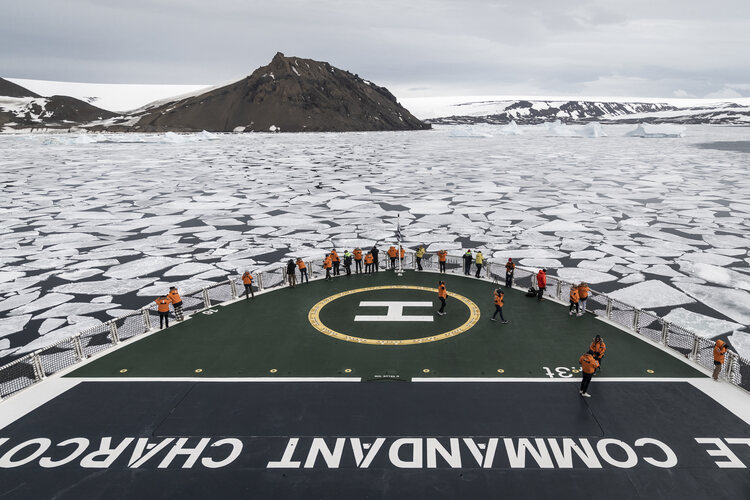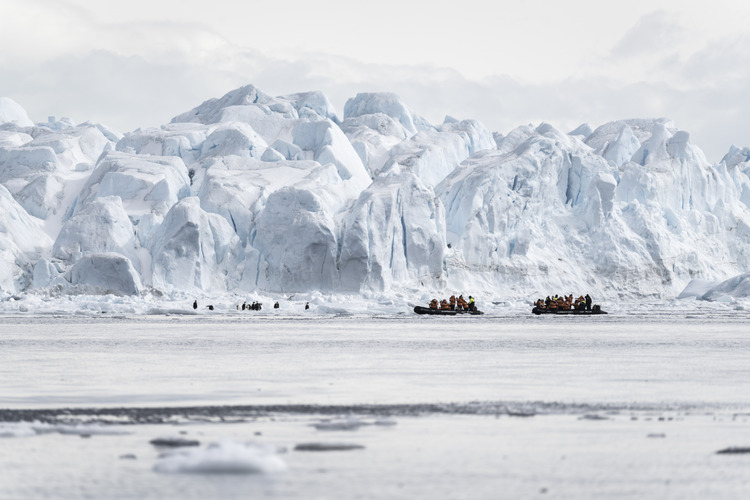
Nicola Moyne speaks to the scientists on-board luxury icebreaker Le Commandant Charcot to find out how tourism is supporting research in Antarctica
Words and photographs by Nicola Moyne
Wind-whipped and whitewashed, the Earth’s most southerly continent is a land of superlatives. We often think of Antarctica as inhospitable – a harsh desert of ice sculptures and imposing glaciers; a place where the maritime pioneers of yesteryear once etched their names into the history books, their legends entombed in a barren, lifeless landscape. Yet, beneath this frozen field of ice floes and tabular bergs, the Antarctic Peninsula is positively teeming with life.
Tourism to this wild and abundant region is on the rise. While cruises used to be prohibitively expensive for all but the very wealthiest, this is now changing and, last year, more than 100,000 tourists visited aboard 700 vessels. These ships vary in size. I was lucky enough to be on-board Ponant’s Le Commandant Charcot – a 31,000-ton, 150m-long exploration ship.

Le Commandant Charcot is one of several ships offering its customers the chance to visit the frozen continent alongside researchers and scientists. Named after the French polar scientist Jean-Baptiste Charcot, the company behind the ship – Ponant – is keen to highlight and emphasise a respect for the environment and the chance to learn from on-board experts.
‘Le Commandant Charcot is a unique ship; a ship of scientific opportunity,’ says Captain Stanislas Devorsine, a former French Navy captain with decades of polar-exploration experience under his sharply polished belt. ‘When we designed this vessel, we started with a hole in the hull to ensure that we could conduct water samples while underway. How many ships can say the same?’

Now in its third year traversing the tempestuous Southern Ocean, Le Commandant Charcot hosts scientific researchers in disciplines such as glaciology, oceanography, marine biology, climatology, and the social sciences. A ‘citizen science’ programme runs hand-in-hand with daily excursions, encouraging guests to experience Antarctica’s wildlife and lunar-esque landscapes as ambassadors rather than tourists.
I’ve joined the ship for a 14-night expedition to the Weddell Sea – a volatile water mass beyond the Drake Passage that provides a gateway to some of Antarctica’s most iconic animals, including emperor penguins, leopard seals, and humpback whales. The ship is undoubtedly luxurious. You could lose yourself in the Michelin-star menu, six-star spa, and stylish interiors, but Ponant does put science and nature at the heart of its offering, with guests actively encouraged to join academic scientists
on the ice, before visiting the purpose-built wet and dry laboratories onboard.
For Daniel Gorman, a research scientist from Australia’s Commonwealth Scientific and Industrial Research Organisation, access to such a ship is proving invaluable. ‘This is the first time that we, as an organisation, have been able to access Antarctica to conduct research,’ he tells me as we stand on a dazzling ice sheet close to Vega Island in the Antarctic Peninsula. ‘We’re hoping to learn more about the algae, plankton, and kelp forests that exist beneath the surface – it’s such an incredible opportunity to gather data,’ he adds, visibly excited as he drops a specialist Niskin bottle though a drilled hole in the ice to gather samples at pre-set depths.

It will be months before the data can be properly analysed and used in any wider context, but the team is confident that with each crossing, they’ll learn more about not only this region’s biodiversity, but the planet as a whole. ‘The data we collect today might just help us to unlock something not previously understood about our climate,’ Gorman adds. ‘At the very least, it will provide further insight – invaluable insight – into understanding and protecting the polar regions.’
David Heydon, the ship’s resident geologist, is in agreement. ‘Our science is always involving; we’re always learning about this planet, and that starts with our ocean,’ he tells me as we pass a giant tabular ice berg, its cathedral-like curves shimmering in the sun as the ship effortlessly glides through a cinematic field of packed pancake ice. ‘We’ve only mapped about 30 percent of our oceans so far, and Antarctica is so important, on so many levels, but mainly because of the sea ice that surrounds it, which changes significantly according to the season. In summer [November- March], there’s 3 million square kilometres here; by winter, that’s increased to about 18 million square kilometres – and we still don’t know what lays beneath this ice. In fact, we know more about the surface of the moon than we do about the lifeforms in Antarctica, which is where innovative ships like this come in; they can help us to fill in the gaps.’

It’s a sentiment that naturalist and oceanographer Nico Servel shares. ‘If you think about it, plankton is God – the actual building blocks of life,’ he says while sipping a coffee in Le Commandant Charcot’s main lounge. ‘That’s what really fascinates me here. Antarctica is overflowing with life. Most guests come to marvel at the majestic emperor penguins and elegant leopard seals – which is understandable – but it’s what we don’t see; the lifeforms that linger, ensconced in the ice beneath us that are really exciting.’
It’s an interesting take on what is undoubtedly an alluring landscape – a winter wonderland punctuated by pristine ice bergs and bathed in summer’s golden glow. The idea is that while guests enjoy kayaking around bays bursting with Adèlie penguins, and hiking through sapphire-blue hummocks – beautiful tunnel formations that our naturalist and guide, Ludovic, crowns Antarctica’s very own ‘ice forests’ – genuine science is also being done.

‘I think it’s the very fact that mankind isn’t welcome here that makes it so appealing,’ Heydon says as we watch a line of emperor penguins snake its way across the ice floe, a smudge of black and white and gold punctuating the pristine white canvas beneath us. ‘This land belongs to the penguins and the whales and the birds. We don’t own it; we can’t lay claim. It’s the one place on Earth that’s dedicated to peace and science; the one truly wild corner left.’
Heading out onto the bow, I watch as the azure sky gives way to an amber-shot glow. Earlier, a pod of orcas were spotted cruising starboard of the ship. Yesterday, we clapped eyes on a humpback whale’s fluke, its mottled silky tail rising and falling beneath the icy waters as petrels glided overhead and a flurry of snow gently dusted the decks.

I can hear the buzz of a caviar- tasting session getting underway in the Observatory Lounge, and I suddenly find myself wondering what Shackleton would have made of it all. His maritime adventures may still be luring pioneers and purists into the near-mythical Southern Ocean but, today, it’s the scientists and naturalists who
are destined to break new ground in Antarctica. Everyone else is just here for the ride. And what an awe-inspiring ride it is.
See ponant.com for details about cruises on board Le Commandant Charcot.




